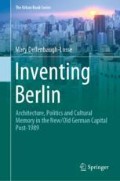Abstract
This chapter frames the later discussion of post-Wall urban development by presenting and discussing spatial symbolism, ideology, and the politicization of Berlin’s urban landscape during the Cold War. This chapter covers the significant waypoints in the development of architectural discourse in the divided city, including Stalinallee in East Berlin and the IBA 1957 in West Berlin in the 1950s, the redesign of Alexanderplatz and the central ensemble in the 1960s, the construction of the Palace of the Republic in the 1970s, and the celebration of the city’s 750th jubilee in the 1980s. This chapter additionally goes into detail about the central role of housing in both halves of the city, the political instrumentalization of housing typologies, and the development of architectural discourse and propaganda during the Cold War on both sides of the Wall—discourses which had a significant effect on these same built spaces after 1990.
Access this chapter
Tax calculation will be finalised at checkout
Purchases are for personal use only
Notes
- 1.
First Secretary of the Socialist Unity Party (SED).
- 2.
Second Secretary of the Socialist Unity Party (SED).
- 3.
For example Lenhart (2001, p. 52).
- 4.
Who was inspired, as already mentioned, by the reconstruction and modernization of Arnimplatz in East Berlin.
- 5.
Hans Stimmann , in the foreword to the first edition of “Stadterneuerung in Ost-Berlin, vom ‘sozialistischen Neuaufbau’ zur ‘komplexen Rekonstruktion,’” which was published as part of the IBA 1987 , made mention of the fact that these parallels were known in professional circles, but that the then-Berliner senator for construction deemed an exhibition about the parallelisms and breaks between the urban development on the two sides of the city in the course of the IBA 1987 “not even worth discussing” (Stimmann 1985, p. 2).
References
Aufbaugesetz (1950) Gesetz über den Aufbau der Städte in der Deutschen Demokratischen Republik und der Hauptstadt Deutschlands, Berlin. Vom 6. September 1950. Berlin
Becker-Cantarino B (1996) Reflections on a changing Berlin. In: Becker-Cantarino B (ed) Berlin in focus: cultural transformations in Germany. Praeger Publishers, Westport, pp 1–33
Birkholz T (2008) ‘Schloss mit der Debatte!’? Die Zwischennutzungen im Palast der Republik im Kontext der Schlossplatzdebatte, Graue Reihe des Instituts für Stadt- und Regionalplanung, Tu Berlin. Verlag der TU Berlin, Berlin
Bolz L (1951) Die 16 Grundsätze des Städtebaus. In: Von deutschem Bauen. Reden und Aufsätze. Verlag der Nation, Berlin (Ost), pp 32–52
Czepczyński M (2008) Cultural landscapes of post-socialist cities: representation of powers and needs. Ashgate, Surrey
Diener AC, Hagen J (2015) From socialist to post-socialist cities: narrating the nation through urban space. In: Diener AC, Hagen J (eds) From socialist to post-socialist cities: cultural politics of architecture, urban planning, and identity in Eurasia. Routledge, London, pp 1–28
Flierl B (2001) Planung und Bau des Palastes. In: Beutelschmidt T, Novak JM (eds) Ein Palast und seine Republik, Ort - Architektur - Programm. Huss-Medien, Berlin
Hain S (1992) Reise nach Moskau: Wie Deutsche “sozialistisch” bauen lernten. Bauwelt 45:1546–1558
Hannemann C (2000) Die Platte. Industrialisierter Wohnungsbau in der DDR. Verlag Schelzky & Jeep, Berlin
Jacobs J (1961) The death and life of great American cities. Vintage Books, New York
Jarausch KH (2010) Beyond the national narrative: implications of reunification for recent German history. German History 28(4):498–514
Jencks C (1977) The language of post-modern architecture. Rizzoli, New York
Kraft, S. (2011) ‘Die Großsiedlungen – Ein gescheitertes Erbe der Moderne?’, ARCH+, 203, pp. 48–54
Ladd B (1997) The ghosts of Berlin: confronting German history in the urban landscape. The University of Chicago Press, Chicago
Le Corbusier (1973) The athens charter. Grossmann, New York
Le Corbusier (1987) The city of to-morrow and its planning, 8th edn. Dover, New York
Lenhart K (2001) Berliner Metropoly: Stadtentwicklungspolitik im Berliner Bezirk Mitte nach der Wende. Leske + Budrich, Opladen
Loshitzky Y (1997) Constructing and deconstructing the wall. Clio A J Lit Hist Philos Hist 26(3):276–296
Pugh E (2014) Architecture, politics, & identity in divided Berlin. University of Pittsburgh Press, Pittsburgh
Saarinen H (2008) Symbolic Places in Berlin before and after the fall of the wall. In: Aunesluoma J, Kettunen P (eds) The cold war and the politics of history. Edita Publishing Ltd, Helsinki, pp 81–107
De Soto HG (1996) (Re) Inventing Berlin: dialectics of power, symbols and pasts, 1990–1995. City Soc 8(1):29–49
Spittler U, Knischewski G (1995) Redefining German identity: case studies in Berlin. J Area Stud 3(7):100–113
Stimmann H (1985) Stadterneuerung in Ost-Berlin, vom ‘sozialistischen Neuaufbau’ zur ‘komplexen Rekonstruktion’, 1st edn. Bauausstellung Berlin GmbH, Abteilung Stadterneuerung, Berlin
Strom EA (2001) Building the New Berlin: the politics of urban development in Germany’s capital city. Lexington Books, Oxford
Venturi R (1966) Complexity and contradiction in architecture. Doubleday, Garden City
Wodak R (1994) Sprache und “Vergangenheiten”. In: Wodak R, Menz F, Mitten R, Stern F (eds) Die Sprachen der Vergangenheiten, Öffentliches Gedenken in österreichischen und deutschen Medien. Suhrkamp, Frankfurt, pp 9–38
Author information
Authors and Affiliations
Corresponding author
Rights and permissions
Copyright information
© 2020 Springer Nature Switzerland AG
About this chapter
Cite this chapter
Dellenbaugh-Losse, M. (2020). The Politicization of Berlin’s Urban Landscape, 1945–1989. In: Inventing Berlin. The Urban Book Series. Springer, Cham. https://doi.org/10.1007/978-3-030-29718-3_3
Download citation
DOI: https://doi.org/10.1007/978-3-030-29718-3_3
Published:
Publisher Name: Springer, Cham
Print ISBN: 978-3-030-29717-6
Online ISBN: 978-3-030-29718-3
eBook Packages: Earth and Environmental ScienceEarth and Environmental Science (R0)

